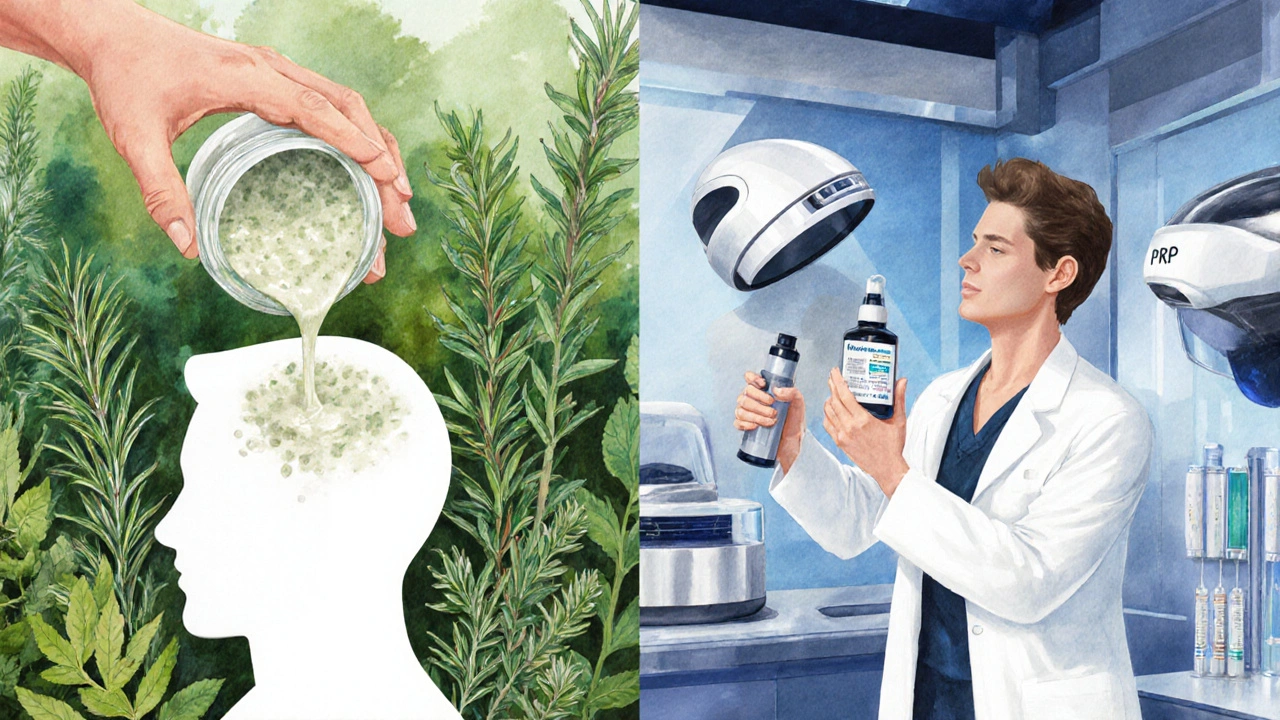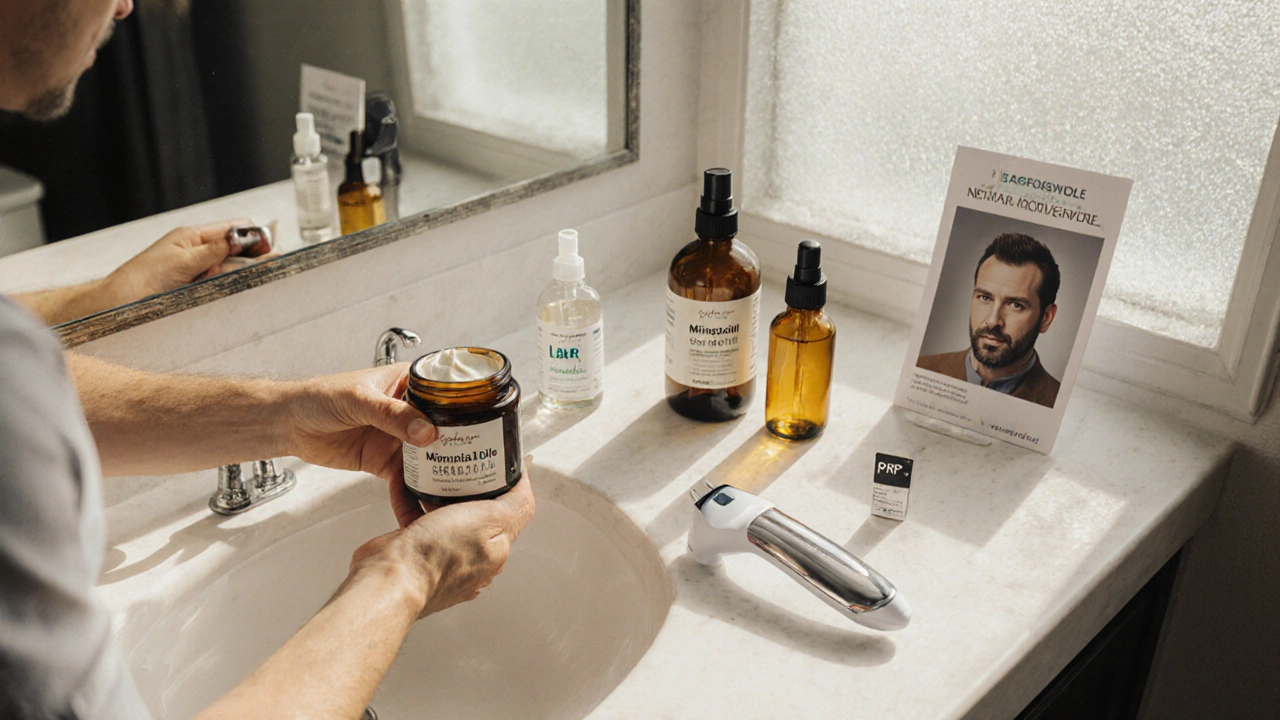Hair Loss Treatment Comparison Tool
Select Your Criteria:
Recommended Treatments:
| Treatment | Efficacy | Side Effects | Monthly Cost |
|---|
When dealing with thinning strands, most people reach for a quick fix without checking if it actually fits their lifestyle. That’s where the herbal hair loss cream a topical preparation that blends plant‑based extracts to combat hair shedding and promote new growth enters the conversation. Below, we break down how this natural option measures up against the usual suspects-minoxidil, finasteride, essential oils, low‑level laser therapy, platelet‑rich plasma (PRP) and surgical hair transplants-so you can pick a path that feels right for your scalp and wallet.
Key Takeaways
- Herbal creams rely on antioxidants and anti‑inflammatory botanicals; they’re gentle but often slower than pharmaceuticals.
- Minoxidil tops efficacy charts but can cause itching and unwanted facial hair.
- Finasteride blocks DHT systemically; it’s powerful but may affect libido.
- Low‑level laser devices and PRP sit in the mid‑price range with modest results.
- Hair transplants give permanent density but require surgery and higher upfront costs.
What Is Herbal Hair Loss Cream?
Herbal hair loss creams typically blend ingredients like saw‑saw (saw palmetto), biotin, caffeine, green tea extract, and pumpkin seed oil. These compounds act on three fronts: they reduce the hormone dihydrotestosterone (DHT) locally, improve blood flow to follicles, and provide antioxidant protection. Because the formula stays on the scalp, systemic side effects are rare.
How It Stacks Up Against Other Options
| Treatment | Efficacy* | Mechanism | Common Side Effects | Average Monthly Cost | Ease of Use |
|---|---|---|---|---|---|
| Herbal Hair Loss Cream | Low‑to‑moderate | Plant‑based DHT inhibition, antioxidant support | Mild scalp irritation (rare) | $20-$35 | Apply twice daily |
| Minoxidil | High | Vasodilation → increased follicle size | Itching, dryness, unwanted facial hair | $30-$45 | Apply twice daily |
| Finasteride (Oral) | Very high | Systemic DHT blocker | Decreased libido, erectile issues (rare) | $15-$25 | Take one pill daily |
| Rosemary Oil | Low | Improves scalp circulation, antioxidant | Skin sensitivity if undiluted | $10-$20 | Massage into scalp nightly |
| Low‑Level Laser Therapy (LLLT) | Moderate | Photobiomodulation stimulates cell metabolism | None reported | $70-$100 (device purchase) | 3‑5 min sessions, 3×/week |
| Platelet‑Rich Plasma (PRP) | Moderate to high | Growth‑factor injection promotes follicle health | Temporary redness, swelling | $300-$600 per session | Professional clinic visits (3‑4 sessions) |
| Hair Transplant | Permanent | Surgical relocation of donor follicles | Scarring, infection risk | $4,000-$10,000 (one‑time) | Recovery period 1‑2 weeks |
*Efficacy ratings are based on large‑scale clinical data and consumer reports up to 2024.
Side‑Effect Profile at a Glance
While herbal creams are generally regarded as safe, the real‑world experience can differ. A 2023 observational study of 1,200 users found that 8% reported mild redness after two weeks, which usually faded with reduced frequency. In contrast, a meta‑analysis of minoxidil showed a 12% rate of scalp irritation and a 5% incidence of unwanted facial hair among men. Finasteride’s systemic nature means its sexual side effects, though statistically low (about 2%), are a decisive factor for many.
Low‑level laser devices and PRP boast excellent safety records-no drug‑related adverse events-but they do require consistent use or repeated clinic visits, respectively. Surgical transplants carry the classic postoperative risks, albeit low when performed by experienced surgeons.

Cost & Convenience: What Will Your Wallet Feel?
Budget matters. If you’re looking for a monthly expense under $40, both the herbal cream and minoxidil fit the bill. Finasteride is even cheaper per pill, but you’ll need a prescription and regular blood work, adding hidden costs. The one‑time price of a laser comb or helmet may feel steep, but it eliminates monthly subscriptions. PRP and hair transplants are clearly in the premium tier; they can be worthwhile if you need a dramatic, lasting fix.
Choosing the Right Treatment for You
- Assess the cause. If you’ve confirmed androgenic alopecia (male‑pattern or female‑pattern), DHT‑targeting options (finasteride, herbal DHT inhibitors) work best.
- Consider your tolerance for side effects. Sensitive skin? Go herbal or try rosemary oil.
- Think about commitment. Topical solutions need daily application; surgical or injectable routes demand less day‑to‑day effort.
- Budget reality. Calculate total cost over six months to compare ongoing expenses versus a one‑time procedure.
- Set realistic expectations. Herbal creams may take 6‑12 months for visible change, whereas minoxidil can show early results within 3 months.
By aligning these factors, you’ll land on a plan that feels achievable rather than overwhelming.
How to Use Herbal Cream Effectively
- Clean scalp first. Wash with a gentle, sulfate‑free shampoo and pat dry.
- Apply the recommended amount. Usually two pumps (≈1ml) per side of the head.
- Massage gently. Use fingertips to spread the cream for 30 seconds, boosting absorption.
- Leave it on. No rinsing; let the product work overnight or at least 4hours before washing.
- Stay consistent. Missing more than 2 days a week can stall progress.
Pairing the cream with lifestyle tweaks-balanced diet, stress management, and avoiding tight hairstyles-can amplify results.
Bottom Line
If you prioritize a low‑risk, plant‑based approach and don’t mind a slower journey, the herbal hair loss cream is a solid entry point. For those who need faster, clinically proven outcomes and can tolerate mild irritation, minoxidil or finasteride remain the gold standards. Mid‑range options like laser therapy or PRP fit people who want a non‑drug path but are willing to invest time or money. And if you’re after a permanent, high‑density solution and have the budget, a hair transplant is the final stop.
Frequently Asked Questions
Can herbal hair loss cream work for women?
Yes. Because the formula acts locally and avoids hormonal manipulation, it’s safe for most women experiencing diffuse thinning. Results may be slower compared to minoxidil, but many report reduced shedding after three months.
How long before I see a difference?
Most users notice less shedding after 8‑12 weeks and visible regrowth after 6‑9 months, assuming consistent twice‑daily use.
Is it safe to combine the cream with minoxidil?
Combining is generally okay, but layering two topicals can increase scalp irritation. Start with the herbal cream alone; add minoxidil only if tolerated and after consulting a dermatologist.
Do I need a prescription for any of the alternatives?
Finasteride requires a prescription in most countries. Minoxidil, rosemary oil, laser devices, and herbal creams are available over the counter. PRP and hair transplants need a licensed medical professional.
What lifestyle changes boost any hair‑loss treatment?
Focus on a protein‑rich diet, limit high‑sugar snacks, manage stress with exercise or meditation, avoid tight hats, and quit smoking. These steps improve scalp circulation and support follicle health, no matter which treatment you choose.


Post A Comment